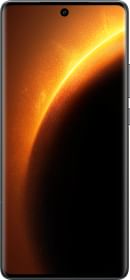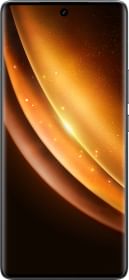Vivo’s X series has been winning over smartphone photography fans for a while now. The X90 Pro, released last year, impressed us with its lens prowess. Now, in 2024, Vivo enters the Indian market with the X100 Pro, boasting a triple 50MP camera setup and promising even greater photographic prowess. But is it enough to shake up the competitive landscape?
Beyond the camera, Vivo has also amped up the display, chipset, and other key features. So, does the X100 Pro have what it takes to stand tall amongst the camera kings of 2024? Well, let’s find out in this Vivo X100 Pro review.
Vivo 100 PRo 5G Review Snapshot
Editor’s rating: 4/5
Design
Display
Software
Performance
Camera
Battery
Jump To..

Pros
- Appealing design
- Excellent Display
- Smooth performance
- Superb optics and ZEISS luts and filter
- Super-fast charging speeds
Cons
- Presence of bloatware
- No 4k recording from selfie camera
Vivo X100 Pro Price in India and Box Contents
Priced at Rs. 89,999, the Vivo X100 Pro offers a 16GB RAM + 256GB storage variant.
The Vivo X100 Pro box includes a premium quality TPU case, a USB Type-C to USB Type-C cable, and a 120W SuperVOOC charging adaptor.
- 16GB+256GB – ₹89,999
Vivo X100 Pro review: Design
Vivo X100 Pro isn’t very far from its predecessor in terms of design. That said, Vivo has made some noticeable alterations in the design. They’ve traded that faux leather back for a smooth, AG frosted glass job that feels amazing in your hand (and doesn’t collect fingerprints like crazy). In India, it comes in only Asteroid Black and shimmers in the light. Smudge-proof glass back, this phone feels fancy without the fingerprint fiesta. It’s a tad slippery though, and the big camera bump makes it a bit top-heavy. The X100 Pro weighs 221g which means lighter than the Galaxy S23 Ultra (234g).
Now, here’s where it gets interesting. Vivo’s gone for a two-step camera bump design. First up, a crescent-shaped outer ring with fine ridges, adding a dash of elegance. Interestingly, Vivo has opted for a two-step design for the camera bump. The first one is a crescent-shaped outer ring with fine ridges, adding to its elegance. From that ring juts out a large circular camera that covers almost 70 percent of the rear panel’s width. That’s a clever move by Vivo – that two-step design makes the camera bulge seem sleeker and oh-so-stylish. The triple LED flash can be spotted in the top right corner of the phone.

Guess who Vivo’s teamed up with again? Zeiss – and you can see it loud and clear on the X100 Pro’s rear. Zeiss logo, T* marking, a nod to Vivo and Zeiss co-engineering, and, of course, the Vivo logo etched on the bottom half of the rear panel.
The facia of the phone is dominated by an OLED screen surrounded by slim bezels. The display of the phone also houses an optical fingerprint sensor, which is slightly lower than what we would have preferred. The display and rear panel both curve near the edges, ensuring the phone feels premium and comfortable in hand.
The side rails, made of glossy aluminum, feature the volume rocker and power button on the right edge along with a couple of antenna bands. Interestingly, Vivo has used a plastic housing at the top, which features an IR blaster and a noise-canceling mic.


Down at the bottom edge, you will spot a SIM slot for dual Nano SIMs, a mic, a Type-C USB port, an antenna band, and loudspeaker grills. Vivo has also ensured that the X100 Pro can withstand water and dust, earning itself an IP68 certification. So, is the X100 Pro a head-turner? Definitely.
VIvo X100 Pro review: Display and Sound
Once again, Vivo has trusted BOE to supply the 8T LTPO AMOLED panel for its flagship. The X100 Pro rocks a 6.78-inch curved AMOLED panel that hits up to 120Hz on the refresh rate clock. The panel has a 1260×2800 pixels resolution, and thanks to its adaptive capabilities, the refresh rate can go as low as 1Hz to conserve battery.

Vivo claims a peak brightness of 3000 nits for the X100 Pro’s display. While we can’t run the numbers ourselves, in real-world use, it looks legitimately bright even in places where the sun is at its brightest. Vivo has added 2160Hz Pulse Width Modulation to protect against eye strain caused by screen flicker. The panel supports 10-bit colors, meaning you can stream HDR 10 and HDR 10+ content on most platforms. Keep in mind, though, Dolby Vision content streaming is a no-go, as Vivo hasn’t secured the licensing for it.

As for colors, Vivo offers three color profiles to choose from – Standard, which is also the default, Pro mode, and Bright, which delivers boosted colors. Pro mode appears to be the most accurate among the three modes. But Vivo goes beyond the basics, offering an adaptive ambient light color temperature feature that adjusts the screen’s hues based on your surroundings, curbing eye fatigue. The brand also introduces an AI-based Smart Eye Protection option, an intelligent adjustment of the blue-light ratio without compromising color balance. Kudos, Vivo.

The X100 Pro features a hybrid stereo speaker setup, using the earpiece and loudspeaker to create a stereo effect. It’s not gonna blow your mind, but it’s loud and clear enough for your favorite tunes and podcasts.
VIvo X100 Pro Review: Camera
The Vivo X100 Pro packs a highly versatile camera setup, co-engineered by Vivo and Zeiss, delivering fantastic results. The default camera app utilizes the 50MP Sony IMX989, a 1-inch type camera sensor with a focal length equivalent to 23mm. To capture more in a single frame, Vivo introduced a 50MP Samsung JN1 ultrawide camera with a 15mm focal length and autofocus capability.

But wait, there’s more! Vivo also all features a 50MP Zeiss floating periscope, demonstrating some mastery. This sensor, originally a 64MP sensor from OmniVision, strategically utilizes only the central 50MP portion for telephoto purposes. The floating design isn’t just for show; it ensures stellar optical image stabilization on the telephoto lens, boasting a 4.5-stop CIPA level.
For selfies, there’s a 32MP front camera. Now, moving on from the camera hardware, let’s delve into the photos.








The primary rear camera steals the show with an impressive dynamic range, capturing photos that are not just crisp but bursting with vivid colors. It excels in maintaining a balance between highlights and shadows, an area where many smartphones struggle. In all the shots taken in Hong Kong, one thing was evident – no visible noise and the subject had good details. The primary camera outperforms the other two in low light, thanks to its larger sensor capturing more light, vibrant colors, and delivering sharp and less noisy shots.
Now, onto the upgraded telephoto camera on the Vivo X100 Pro, which is versatile and offers up to 4.3X telephoto zoom, also excelling in macro shots. Leveraging in-sensor zoom and telephoto capabilities, Vivo introduces Multi-Focal Portraits, a feature that lets you capture stunning images at various focal lengths – 24mm (1x), 35mm (1.5x), 50mm (2.2x), 85mm (3.7x), and 100mm (4.3x). Thanks to its partnership with Zeiss, the Vivo camera app offers Zeiss lens effects and LUTs – highly recommended if you plan to buy the Vivo X100 Pro.
However, the Vivo X100 selfie game is an Achilles’ heel for the phone. Selfies tend to be slightly soft, and vloggers might miss a 4K recording option on the front camera. Despite this, the Vivo X100 Pro is an impressive camera phone.
Vivo X100 Pro review: Performance
For its flagship phone in 2024, Vivo has opted for the MediaTek Dimensity 9300 SoC. This chipset is based on the 4nm fabrication process. It is based on BigLittle architecture and boasts a dynamic configuration – 4 Cortex-X4 performance cores clocking up to 3.25GHz and 4 Cortex-A720 efficiency cores reaching speeds of up to 2.0GHz. Vivo also threw in a V3 co-processor to complement the main processor for graphics and videography. The Immortalis-G720 MC12 GPU takes charge of the graphics department, ensuring a visually immersive experience.

The software’s no slouch either – Android 14 with Funtouch OS 14 is clean and user-friendly, with less of that annoying bloatware. Vivo has got rid of Hot Apps and Hot Games – a commendable move, though the scope for further refinement still exists. Funtouch OS 14 steps also offers several customization features, ranging from themes and icon packs to clock styles and dynamic wallpapers. Navigating through the UI proves a fluid and glitch-free experience, making it user-friendly.

In daily use, this phone flies. Apps open like greased lightning, even the chatty ones like Twitter and WhatsApp. Games like Call of Duty run like butter on high graphics, thanks to that beefy 16GB of RAM. But here’s the catch: after about 15 minutes of intense gaming, the phone gets a bit toasty and throttles down slightly. It’s still playable, but not quite the fire-breathing dragon you were hoping for.

In real-world usage, distinguishing between the two chipsets proves challenging. The Vivo X100 Pro stands out as one of the fastest Android phones on the market, delivering a seamless multitasking experience thanks to its substantial 16GB onboard memory. Throughout our testing period, we encountered no lag or slowdown in popular apps like Twitter, Gmail, WhatsApp, or Chrome.
The chipset effortlessly handles demanding games like Call of Duty: Mobile at the highest graphics settings, demonstrating smooth performance without heating concerns. Vivo’s V3 co-processor adds a unique touch, enabling frame interpolation in specific games like COD Mobile and Asphalt 9.
Returning to performance specifics, the X100 Pro is exclusively available in a 16GB/256GB variant in India. While it adeptly handles AAA games initially, prolonged gameplay triggers thermal throttling to manage temperatures. The MediaTek chip tends to throttle performance to approximately 80 percent after 15 minutes of gameplay, a result confirmed by our throttle test. Here are the results of various synthetic benchmark tests conducted on the Vivo X100 Pro:


- AnTuTu: 19,36695
- Geekbench 5: 2,207 (single-core) and 7,012 (multi-core)
- 3DMark Wild Life Extreme Stress Test:4059 (best loop score) and 1935 (lowest loop score)
Vivo X100 Pro review: Battery and Charging
The Vivo X100 Pro packs a hefty 5400mAh battery, promising to keep you powered up all day long. While it doesn’t quite reach the stratospheric heights of some competitors in terms of screen-on time (hovering around 6.5 hours in our tests), it’s certainly not a slouch. This is because MediaTek chipset seems to be a bit thirstier than its Snapdragon counterparts.



But where the X100 Pro truly shines is in the charging department. This bad boy comes with a 120W brick (yes, you read that right!) but the phone caps out at 100W charging. Once plugged in for charging, the phone leaps to life from a dead state in just 2 seconds, and a complete battery refill is achieved in a mere 30 minutes.
This phone also supports wireless charging at a respectable 50W, meaning you can ditch the wires altogether if you have a compatible charging pad. Plus, if you’re the kind soul who likes sharing their juice, it even has 5W reverse wireless charging.
Vivo X100 Pro review Verdict: Should you buy it?
Are you a smartphone photography enthusiast? If so, the Vivo X100 Pro demands your attention. It’s a serious camera phone offering a versatile camera that shines especially in capturing landscapes, portraits, macros, and zoom shots.
But there’s more to this powerhouse than just impressive camera capabilities. The X100 Pro doesn’t just stop at being a photography maestro; it’s a reliable performer in every aspect. And let’s talk about speed – the X100 Pro takes the lead with excellent everyday performance, and remarkable charging speeds, giving it a competitive edge over its rivals. If you’re serious about your smartphone photography game, the Vivo X100 Pro is a must-see, promising to elevate your imaging experience to new heights.
Reasons to buy
- Appealing design
- Excellent Display
- Smooth performance
- Superb optics and ZEISS luts and filter
- Super-fast charging speeds
Reasons To Not Buy
- Presence of bloatware
- No 4k recording from selfie camera



































8000